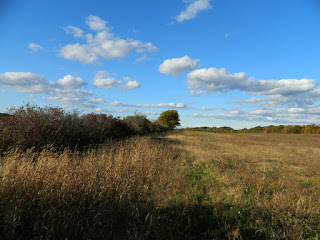 |
| The hedge row |
This fall, inspired by videos of people starting trees from seed I collected a bucket full of acorns from the "mighty" oak that is in an old fence line hedgerow in the field behind us. The fence line has obviously existed for some time and remnants of three different type of fencing materials can be found - stone, wire, and wood. For this collection work, I used one of my favorite foraging/harvesting tools -- a $0.99 plastic children's sand pail. With an hour's worth of work, I was able to collect most of a bucket's worth of acorns.
I figure this tree is an exceptional source for seed as it grows in a tiny sliver of wild between two farm fields and those fields have been badly abused by 100+ years of broken agricultural practices. The soil in those fields is spent and crops only grow with chemicals. It took me 15 years of letting the ground lay fallow just to be able to support tree growth in the land I have that used to be part of these fields. So if this oak, the mother/hub tree of this area, has survived and thrived in spite of that, it hopefully will provide some nice local genotype stock to add to my young food forest plantings.
 |
| My "Mighty Oak" |
So with a 5 galleon bucket full of water, I separated the bad from good seed. The bad ones float. I lost two-thirds to three-quarters of the seed that I harvested. And the water showed why, bugs. Lots of acorn eating larvae floated up with the water. I never imagined I would end up with so few acorns left. But regardless, I sowed some in pots to let the winter do her germination magic and will move any spouted seeds to larger containers come spring. I also scattered some in the wild areas to let the acorns sprout and grow all on their own.
Not long after this, I visited a local nature center with healthy and strong forest areas of pines, oaks, beeches, and more. On a whim, I collected 2 handfuls of acorns from underfoot on the trails. When I soaked them in water to separate out the bad from the good, I got completely different results. I ended up with somewhere between one-fifth and one-tenth loss.
After considering the results for a while, it became clear why I saw such different experiences. The oak behind my house is one of only a couple of acorn producing trees in the that hedgerow. Whereas the nature center has many, many such trees. "My" tree is supporting more than its fair share of native fauna life and is in a sense to those creatures, like a glass of water for a man in the desert dying of thirst. If you can, plant oaks as they are powerhouses of support for our native animal life. See writings by Doug Tallamy to learn about just how critical they are.
And I will let you know come spring time how my acorn germination project has fared.
Some additional photos:
 |
| An oak gall - a small insect grows inside of these on oak trees |
 |
| Acorns and leaves of my "mighty" tree |
 |
| What lies at the oak's feet - old fence line materials |
 |
| The few good acorns after sorting |
 |
| Turkey tail fungi growing under the oak's canopy |









